Over the past decade, we have seen the huge growth of pasture rejuvenation equipment in Ireland and across many parts of Europe. One company specialising in manufacturing such equipment is Alstrong in Co Galway. Now 13 years in the machinery manufacturing business, the firm offers a grassland aerator and its Auctus one-pass reseeding unit.
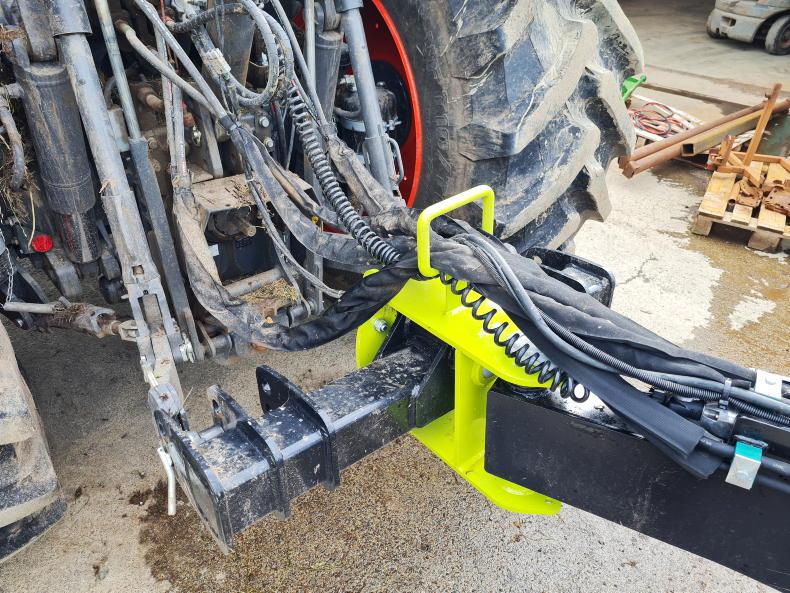
For 2022, a new gyroscopic drawbar system was fitted, replacing the outgoing design of a straight draw bar towed via the pick-up hitch.
During the summer, the Irish Farmers Journal got an opportunity to put the Auctus to work in varying conditions, sowing over 50 acres across a variation of grass and small seeds.
The design
The Auctus is available as a mounted or trailed unit, both of which are only currently offered in a three-metre working width. The versatile machine is designed to sow seed into ploughed ground, burnt-off or existing pasture in a one-pass solution.
We got our hands on a trailed unit. For 2022, the trailed unit was tweaked, and is now attached via a two-point linkage, which replaced the outgoing design of a straight drawbar towed via the pick-up hitch.
This new gyroscopic drawbar system, which is connected via the lift arms, was a big step up in terms of manoeuvrability of the machine and is now a standard feature.
The new design allowed us to access tight gaps off narrow roads, which wouldn’t have been possible with the older design. Aside from the axle, the only difference between the mounted and trailed is that the trailed version comes with a prism rear roller.
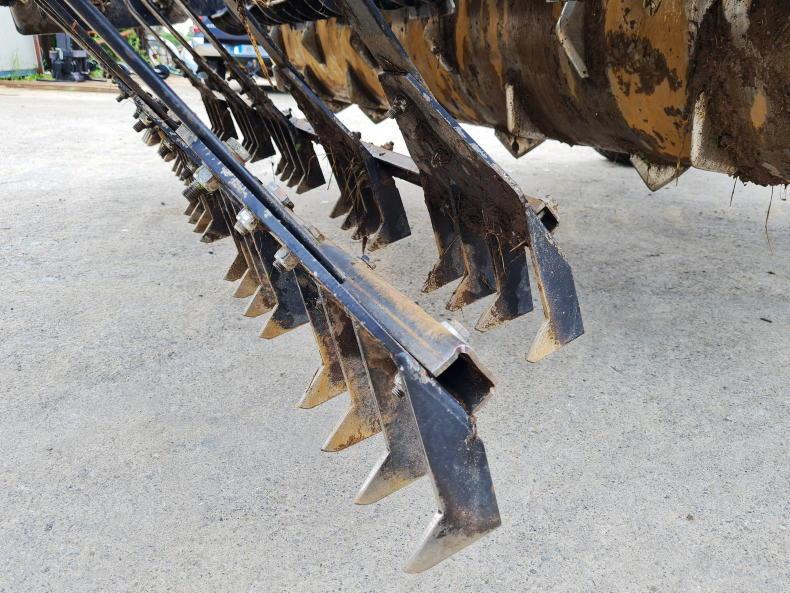
Up front, the Auctus features two rows of hydraulically adjustable sprung ripper paddles.
Up front, the Auctus features two rows of hydraulically adjustable sprung ripper paddles. Each row features six paddles, which are offset. Each row of paddles is braced from one end to the next, helping to distribute stress and strain. These are designed to scarify and scratch the surface and remove dead material. For 2022, Alstrong also modified these paddles, adding a far more aggressive set of tips. Although a minor tweak, we found this was a major step forward, almost transferring them from acting as levelling boards to proper ripper paddles. The move allows the machine to perform in tougher conditions.
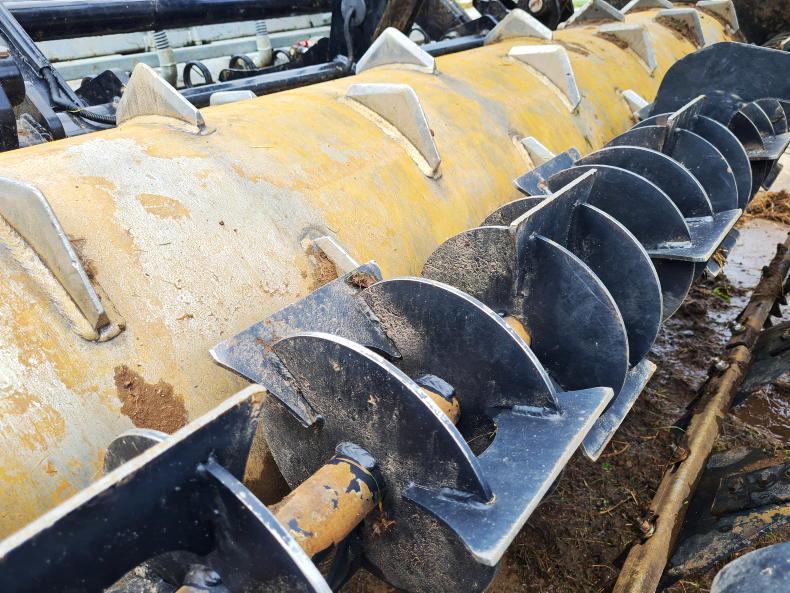
The spiked drum is fitted with 60, 80mm hardened steel aeration blades and is kept clean using the free-wheeling ‘revolving scraper’.
Spiked roller
Following this is a spiked drum fitted with 60, 80mm hardened steel aeration blades. According to Alstrong, this is designed to both repair poached soil and penetrate the surface to help aeration. If more weight and downward force is required, this hollow roller can be filled with water. This additional ballast increases the unit’s dry weight from 4.5t to a laden weight of up to 5.3t, adding 800kg.
The aeration roller will naturally always be in contact with the soil, and thus is prone to soil sticking to its surface when working in sticky conditions. It’s widely known that such tacky conditions are where the likes of these machines will produce their best results. Alstrong recognised this and for the 2022 season introduced a new ‘revolving scraper’. This is essentially a free-wheeling scraper roller which runs close to the drum, in between the spikes, to keep it clean.
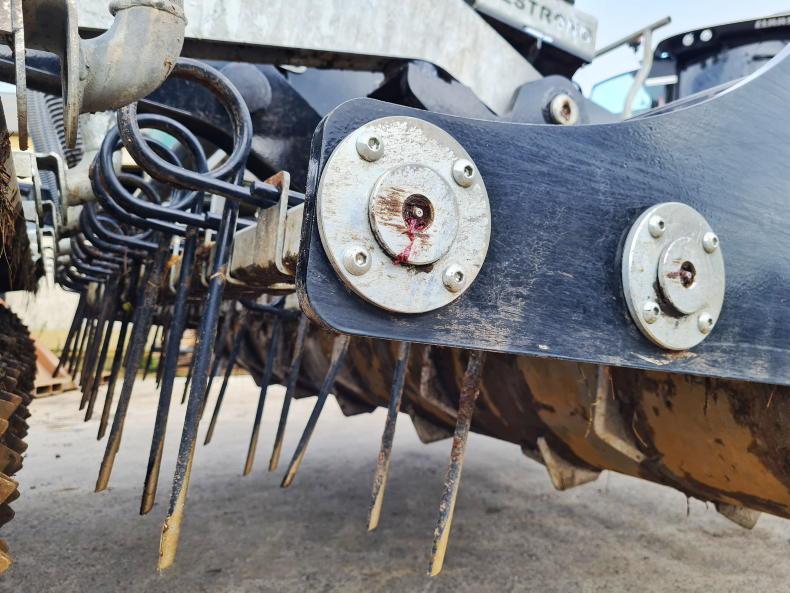
Behind the drum sit two rows of hydraulically controlled 12mm tines.
Behind the spiked drum sit two rows of hydraulically controlled 12mm tines. Again, the hydraulic control means the aggressiveness of the tines can be adjusted on the move, from the cab, in a similar fashion to the levelling paddles.
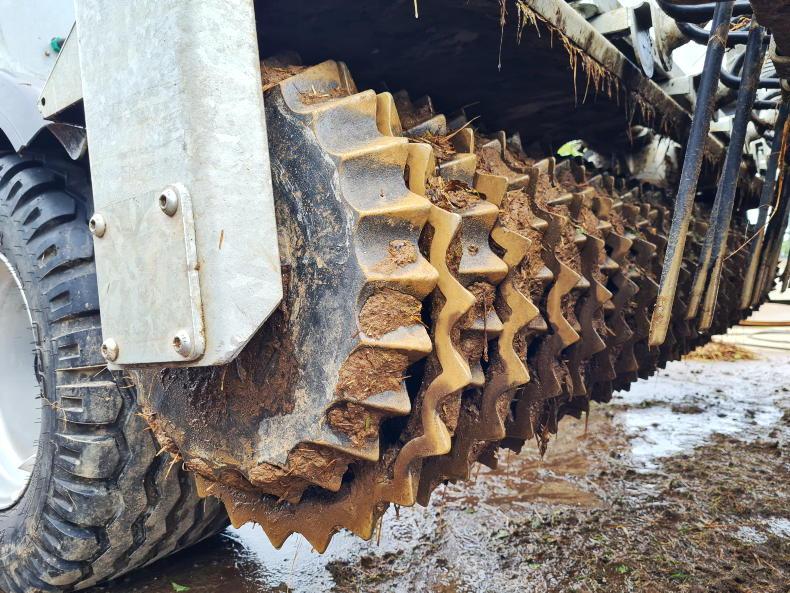
Finally, the 560mm prismatic roller covers the seed, consolidating the seedbed.
Finally, the 560mm prismatic roller covers the seed, consolidating the seedbed. The heavy-duty structural steel frame is constructed from 200x100x10mm box iron. It comes shod on 19.0/45-17 flotation tyres which sit under a presentable set of mudguards, all now coming as standard.
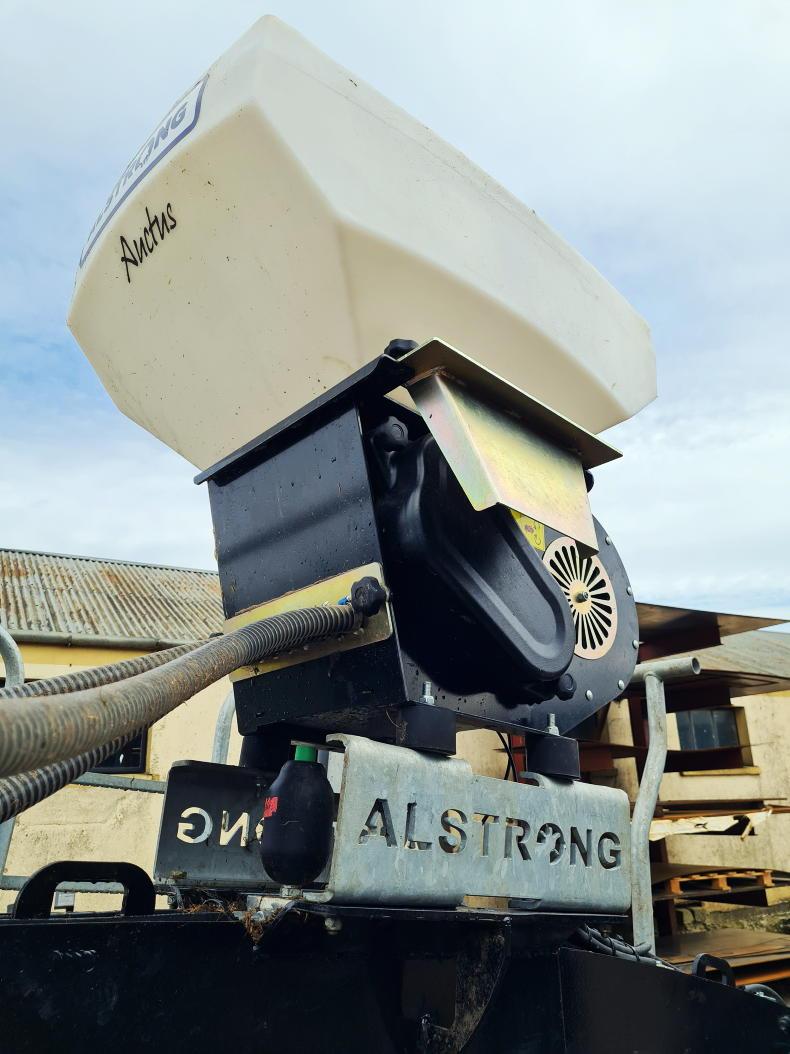
Alstrong use the Kildare manufactured Doyle pneumatic ‘Vario’ air seeder.
Seeding unit
Keeping things local, Alstrong uses the Kildare-manufactured Doyle pneumatic ‘Vario’ air seeder. This broadcasts the seed via eight little splash-plate type designs across the width of the unit. The seed is distributed after the tines and before the prism roller.
Alstrong uses Doyle’s Total Control unit which uses a GPS speed sensor to pick up ground speed. The firm has this sensor set up in such a way that once the unit is lowered into the working position, a green light followed by a beep will notify the operator that the seeder has begun distributing seed.
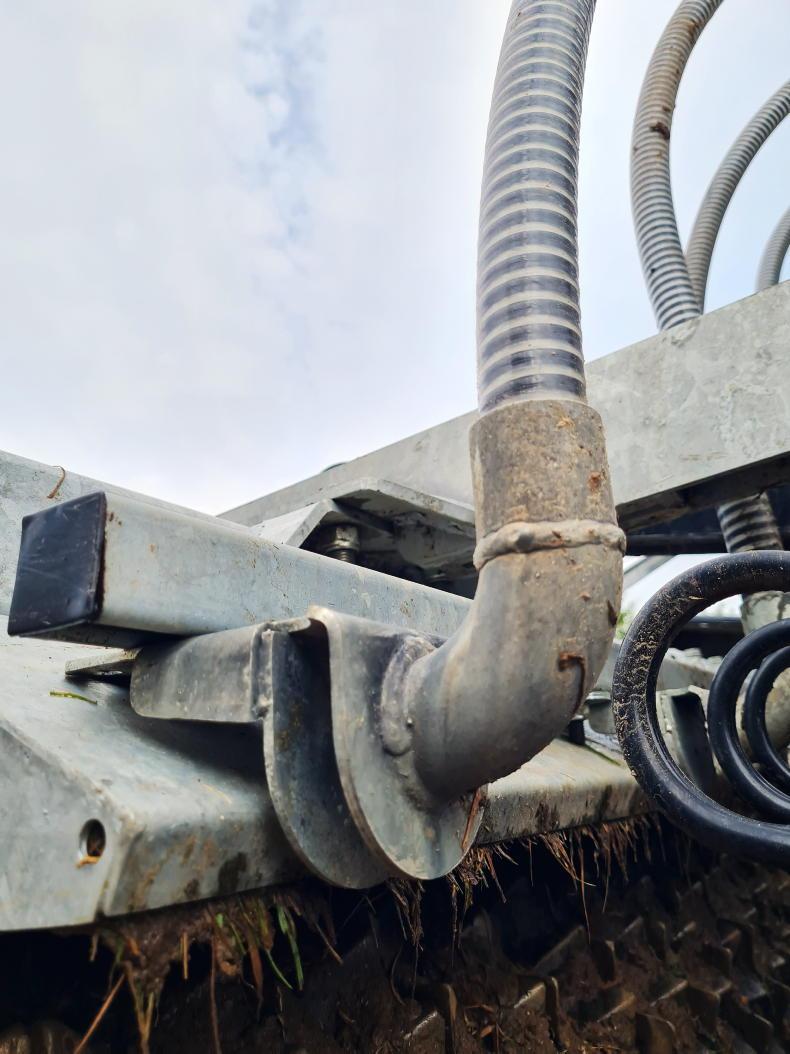
The seed is broadcasted via eight little splash plates after the tines and before the prism roller.
The Vario seeder is capable of sowing fine seeds from a rate as low as 1kg/ha to sowing grass seeds at up to 80kg/ha. Changing to small seeds involves swapping the rollers. We also applied slug pallets through the unit, which worked fine.
The air seeder is powered off a 12-volt 80nm motor which drives fluted feed rollers.
Alstrong recommends connecting this direct to the battery to avoid any interruptions in current such as when using lights or air conditioning etc. This is also the case as the manufacturer uses high-capacity twin electric impeller fans for a reliable spread, which can require a little extra power when starting up.
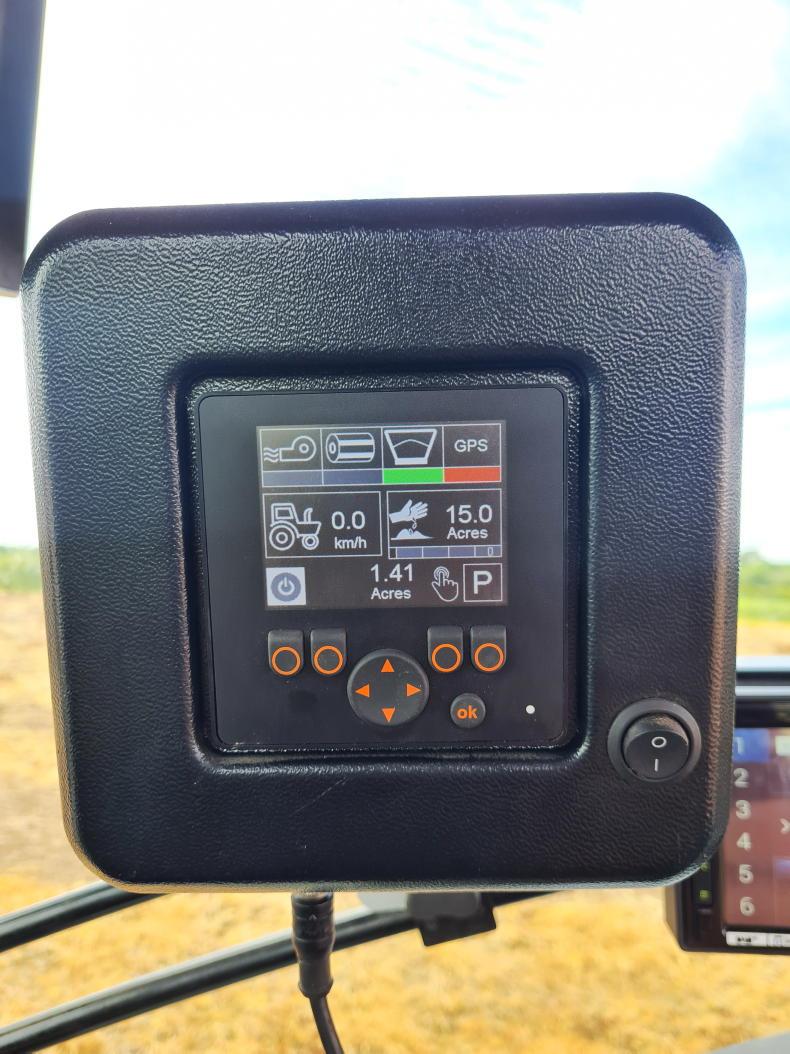
The seeding unit comes with a control box which offers seed rate change on the move, a hopper low level warning, an acre meter and a live groundspeed reading.
The seeding unit comes with a control box which offers seed rate change on the move, a hopper low level warning, an acre meter and a live groundspeed reading. Once initial calibrations were weighed, recorded and established, it was seriously easy to alter rates while on the move. Despite its initial clunky look, it didn’t take too long to get to grips with the control box which we soon grew fond of. The one improvement we could suggest here is an increased capability to hold calibration memory settings to help speed up the operation.
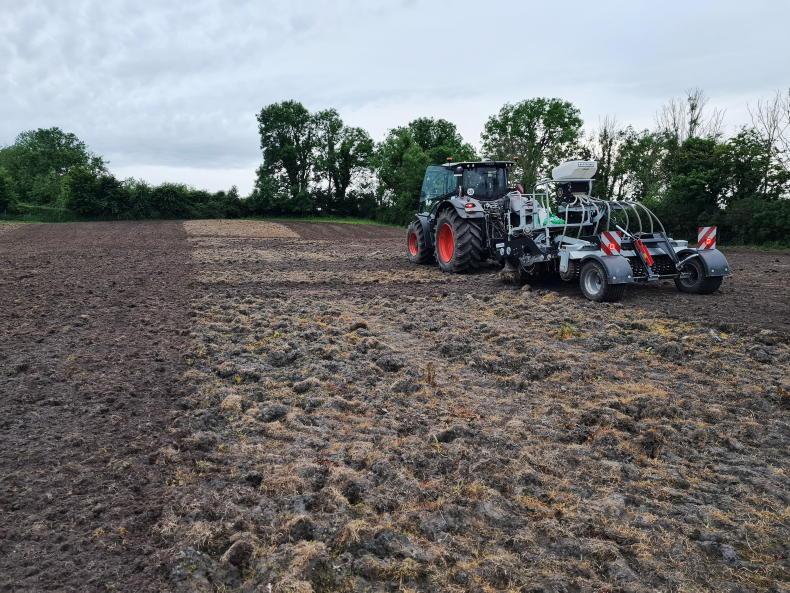
The Auctus left a nice finish with one pass through ground which was sprayed off six weeks and had cattle out-wintered on.
Tractor requirement
Alstrong says a minimum power requirement of 140hp is recommended for the trailed unit.
The tractor we ran the Auctus on was overkill, and pulled it at its ease as we expected.
We have spoken to several contractors running these machines and the unanimous verdict is that 150-160hp is the sweet spot.
On the road, the axle is rated to be pulled at 50km/h. A nice touch by the manufacturer, it fitted the axle’s hydraulic system with a pressurised accumulator which allows for smooth transportation by taking the shocks out of it.
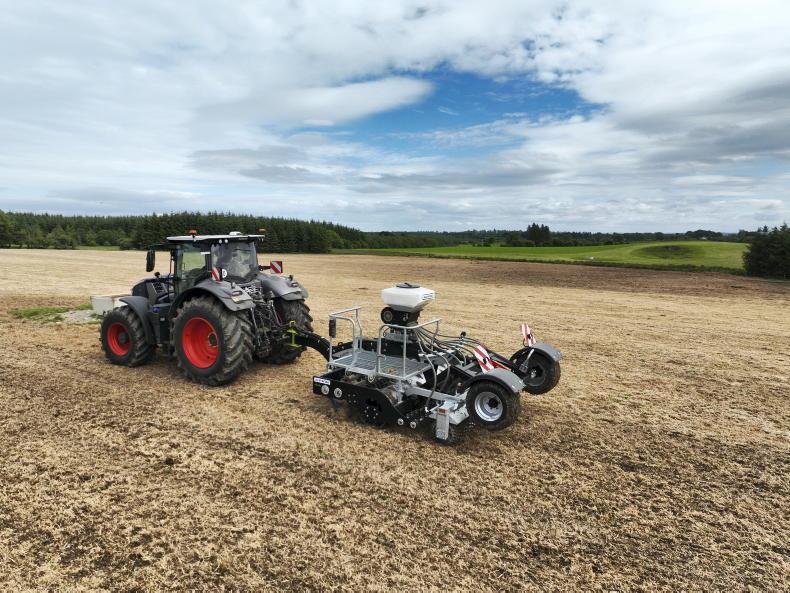
Alstrong says a minimum power requirement of 140hp is recommended for the trailed unit.
There are many types of min-till stitching methods on the market nowadays for boosting existing pasture and for carrying out complete re-seeding on burnt-off ground. All methods work, but all are very much dependent on the conditions at hand and the operator behind the wheel.
Conditions such as thrash content, the soil fertility and the weather are prime examples. Like all machines, the Auctus has its limitations. If ground is too wet or if there are large amounts of thrash, in particular long fibres, it will cause a build-up of debris on top of the aeration roller which can take time to manually clear.
Aggressive nature
The one comment I will make on the Auctus is that its aggressive nature and weight means it’s a machine that will allow you to push the boundaries that little bit more than some of its competitors.
Many of its competitors are quite light in weight and are designed for minimal disturbance. The Auctus almost is in a class of its own. You can go from a tilling a ploughed field to carrying out a reseed on burnt off ground to a rejuvenation job without having to change any settings, apart from adjusting the paddles and (or) tines from the cab.
I could only pick out a couple of gripes or things I would tweak. The seed hopper is on the small side; it will just hold six 12kg bags. It could do with at least being doubled in size. A little compartment to safely store the small or big seed wheels when not being used would be welcomed. The platform is roomy and well put together, but it needs to be caged off for safe storage of bags of seed, or even a fitted with a compartment for storage. Other than that, if the clock had more capability to hold calibration memory settings it would help speed up the operation.
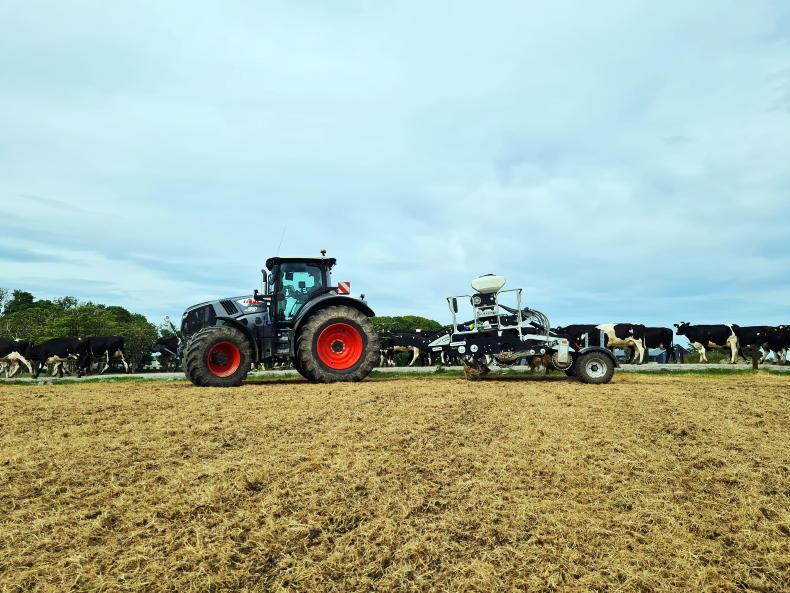
The aggressive nature and weight means the Auctus will allow you to push the boundaries that little bit more than some of its competitors.
Heavy unit
No compromising on steel, the unit is heavy (4.5t dry weight). However, to maximise output you need a good 150-160hp in front of it. A 120hp tractor will pull it, but the machine would bully it.
Somewhat similar to a disc harrow, the machine can be seen doing better work at higher speeds. Given the size of many grassland fields in Ireland, a good-sized tractor is needed to achieve such forward speeds with short runs.
In the right fields, the machine has a serious capability of getting through work, quickly. The fact you can just lift the unit out of the ground on the move and likewise drop it on the go when turning on headlands is a key factor allowing the machine to achieve high work rates. We pushed the machine to forward speeds of 18-20km/h while seeding, which didn’t affect the final result. Overall, we found it to be a hugely versatile and seriously well-built piece of kit.

Prices for the Auctus T (trailed machine) start at €35,000 plus VAT, while prices for the mounted version start at €20,000 plus VAT.
Pricing
The machine now comes finished in black styling with quite a few galvanised components and LED lights as standard specification. Prices for the Auctus T (trailed machine) start at €37,000 plus VAT, while prices for the mounted version start at €22,000 plus VAT.
We pushed the machine to forward speeds of 18-20km/h while seeding, which didn’t affect the final result.
Who are Alstrong?
Alstrong is based just outside the small town of Killimor in south county Galway. The firm is headed up by Alan Winters.
A trained fitter fabricator by trade, Alan set up the business during the economic downturn in 2009, turning his weekend and evening welding and fabrication side hustle into a full-time career.
In his first year in business, he built a prototype aerator. He wanted to design a machine that would do the work of a subsoiler, without bringing up stones, while getting through ground faster. That year, Alan built 10 machines, followed by 25 the year after. In 2015, he set about designing the Auctus, with the first build being a mounted machine.
Today, the manufacturer is exporting machines to Estonia, Latvia, Belgium, Austria and Germany. Alstrong explained that since Brexit, Germany has become its strongest market outside of Ireland. Ireland accounts for 35-40% of sales, followed by Germany at 30% followed by the UK with 15%.
The firm claims to have almost 600 machines built to date.
Model: Auctus T.
Working width: 3m.
Hopper capacity: 280 litres (six bags of grass seed).
Dry weight: 4.5t.
Weight with water ballast: 5.3t.
Tyres: 19.0/45-17 flotation tyres.
Minimum power requirement: 140hp.
Prices start from: €37,000 (£32,000) plus VAT.
Over the past decade, we have seen the huge growth of pasture rejuvenation equipment in Ireland and across many parts of Europe. One company specialising in manufacturing such equipment is Alstrong in Co Galway. Now 13 years in the machinery manufacturing business, the firm offers a grassland aerator and its Auctus one-pass reseeding unit.

For 2022, a new gyroscopic drawbar system was fitted, replacing the outgoing design of a straight draw bar towed via the pick-up hitch.
During the summer, the Irish Farmers Journal got an opportunity to put the Auctus to work in varying conditions, sowing over 50 acres across a variation of grass and small seeds.
The design
The Auctus is available as a mounted or trailed unit, both of which are only currently offered in a three-metre working width. The versatile machine is designed to sow seed into ploughed ground, burnt-off or existing pasture in a one-pass solution.
We got our hands on a trailed unit. For 2022, the trailed unit was tweaked, and is now attached via a two-point linkage, which replaced the outgoing design of a straight drawbar towed via the pick-up hitch.
This new gyroscopic drawbar system, which is connected via the lift arms, was a big step up in terms of manoeuvrability of the machine and is now a standard feature.
The new design allowed us to access tight gaps off narrow roads, which wouldn’t have been possible with the older design. Aside from the axle, the only difference between the mounted and trailed is that the trailed version comes with a prism rear roller.

Up front, the Auctus features two rows of hydraulically adjustable sprung ripper paddles.
Up front, the Auctus features two rows of hydraulically adjustable sprung ripper paddles. Each row features six paddles, which are offset. Each row of paddles is braced from one end to the next, helping to distribute stress and strain. These are designed to scarify and scratch the surface and remove dead material. For 2022, Alstrong also modified these paddles, adding a far more aggressive set of tips. Although a minor tweak, we found this was a major step forward, almost transferring them from acting as levelling boards to proper ripper paddles. The move allows the machine to perform in tougher conditions.

The spiked drum is fitted with 60, 80mm hardened steel aeration blades and is kept clean using the free-wheeling ‘revolving scraper’.
Spiked roller
Following this is a spiked drum fitted with 60, 80mm hardened steel aeration blades. According to Alstrong, this is designed to both repair poached soil and penetrate the surface to help aeration. If more weight and downward force is required, this hollow roller can be filled with water. This additional ballast increases the unit’s dry weight from 4.5t to a laden weight of up to 5.3t, adding 800kg.
The aeration roller will naturally always be in contact with the soil, and thus is prone to soil sticking to its surface when working in sticky conditions. It’s widely known that such tacky conditions are where the likes of these machines will produce their best results. Alstrong recognised this and for the 2022 season introduced a new ‘revolving scraper’. This is essentially a free-wheeling scraper roller which runs close to the drum, in between the spikes, to keep it clean.

Behind the drum sit two rows of hydraulically controlled 12mm tines.
Behind the spiked drum sit two rows of hydraulically controlled 12mm tines. Again, the hydraulic control means the aggressiveness of the tines can be adjusted on the move, from the cab, in a similar fashion to the levelling paddles.

Finally, the 560mm prismatic roller covers the seed, consolidating the seedbed.
Finally, the 560mm prismatic roller covers the seed, consolidating the seedbed. The heavy-duty structural steel frame is constructed from 200x100x10mm box iron. It comes shod on 19.0/45-17 flotation tyres which sit under a presentable set of mudguards, all now coming as standard.

Alstrong use the Kildare manufactured Doyle pneumatic ‘Vario’ air seeder.
Seeding unit
Keeping things local, Alstrong uses the Kildare-manufactured Doyle pneumatic ‘Vario’ air seeder. This broadcasts the seed via eight little splash-plate type designs across the width of the unit. The seed is distributed after the tines and before the prism roller.
Alstrong uses Doyle’s Total Control unit which uses a GPS speed sensor to pick up ground speed. The firm has this sensor set up in such a way that once the unit is lowered into the working position, a green light followed by a beep will notify the operator that the seeder has begun distributing seed.

The seed is broadcasted via eight little splash plates after the tines and before the prism roller.
The Vario seeder is capable of sowing fine seeds from a rate as low as 1kg/ha to sowing grass seeds at up to 80kg/ha. Changing to small seeds involves swapping the rollers. We also applied slug pallets through the unit, which worked fine.
The air seeder is powered off a 12-volt 80nm motor which drives fluted feed rollers.
Alstrong recommends connecting this direct to the battery to avoid any interruptions in current such as when using lights or air conditioning etc. This is also the case as the manufacturer uses high-capacity twin electric impeller fans for a reliable spread, which can require a little extra power when starting up.

The seeding unit comes with a control box which offers seed rate change on the move, a hopper low level warning, an acre meter and a live groundspeed reading.
The seeding unit comes with a control box which offers seed rate change on the move, a hopper low level warning, an acre meter and a live groundspeed reading. Once initial calibrations were weighed, recorded and established, it was seriously easy to alter rates while on the move. Despite its initial clunky look, it didn’t take too long to get to grips with the control box which we soon grew fond of. The one improvement we could suggest here is an increased capability to hold calibration memory settings to help speed up the operation.

The Auctus left a nice finish with one pass through ground which was sprayed off six weeks and had cattle out-wintered on.
Tractor requirement
Alstrong says a minimum power requirement of 140hp is recommended for the trailed unit.
The tractor we ran the Auctus on was overkill, and pulled it at its ease as we expected.
We have spoken to several contractors running these machines and the unanimous verdict is that 150-160hp is the sweet spot.
On the road, the axle is rated to be pulled at 50km/h. A nice touch by the manufacturer, it fitted the axle’s hydraulic system with a pressurised accumulator which allows for smooth transportation by taking the shocks out of it.

Alstrong says a minimum power requirement of 140hp is recommended for the trailed unit.
There are many types of min-till stitching methods on the market nowadays for boosting existing pasture and for carrying out complete re-seeding on burnt-off ground. All methods work, but all are very much dependent on the conditions at hand and the operator behind the wheel.
Conditions such as thrash content, the soil fertility and the weather are prime examples. Like all machines, the Auctus has its limitations. If ground is too wet or if there are large amounts of thrash, in particular long fibres, it will cause a build-up of debris on top of the aeration roller which can take time to manually clear.
Aggressive nature
The one comment I will make on the Auctus is that its aggressive nature and weight means it’s a machine that will allow you to push the boundaries that little bit more than some of its competitors.
Many of its competitors are quite light in weight and are designed for minimal disturbance. The Auctus almost is in a class of its own. You can go from a tilling a ploughed field to carrying out a reseed on burnt off ground to a rejuvenation job without having to change any settings, apart from adjusting the paddles and (or) tines from the cab.
I could only pick out a couple of gripes or things I would tweak. The seed hopper is on the small side; it will just hold six 12kg bags. It could do with at least being doubled in size. A little compartment to safely store the small or big seed wheels when not being used would be welcomed. The platform is roomy and well put together, but it needs to be caged off for safe storage of bags of seed, or even a fitted with a compartment for storage. Other than that, if the clock had more capability to hold calibration memory settings it would help speed up the operation.

The aggressive nature and weight means the Auctus will allow you to push the boundaries that little bit more than some of its competitors.
Heavy unit
No compromising on steel, the unit is heavy (4.5t dry weight). However, to maximise output you need a good 150-160hp in front of it. A 120hp tractor will pull it, but the machine would bully it.
Somewhat similar to a disc harrow, the machine can be seen doing better work at higher speeds. Given the size of many grassland fields in Ireland, a good-sized tractor is needed to achieve such forward speeds with short runs.
In the right fields, the machine has a serious capability of getting through work, quickly. The fact you can just lift the unit out of the ground on the move and likewise drop it on the go when turning on headlands is a key factor allowing the machine to achieve high work rates. We pushed the machine to forward speeds of 18-20km/h while seeding, which didn’t affect the final result. Overall, we found it to be a hugely versatile and seriously well-built piece of kit.

Prices for the Auctus T (trailed machine) start at €35,000 plus VAT, while prices for the mounted version start at €20,000 plus VAT.
Pricing
The machine now comes finished in black styling with quite a few galvanised components and LED lights as standard specification. Prices for the Auctus T (trailed machine) start at €37,000 plus VAT, while prices for the mounted version start at €22,000 plus VAT.
We pushed the machine to forward speeds of 18-20km/h while seeding, which didn’t affect the final result.
Who are Alstrong?
Alstrong is based just outside the small town of Killimor in south county Galway. The firm is headed up by Alan Winters.
A trained fitter fabricator by trade, Alan set up the business during the economic downturn in 2009, turning his weekend and evening welding and fabrication side hustle into a full-time career.
In his first year in business, he built a prototype aerator. He wanted to design a machine that would do the work of a subsoiler, without bringing up stones, while getting through ground faster. That year, Alan built 10 machines, followed by 25 the year after. In 2015, he set about designing the Auctus, with the first build being a mounted machine.
Today, the manufacturer is exporting machines to Estonia, Latvia, Belgium, Austria and Germany. Alstrong explained that since Brexit, Germany has become its strongest market outside of Ireland. Ireland accounts for 35-40% of sales, followed by Germany at 30% followed by the UK with 15%.
The firm claims to have almost 600 machines built to date.
Model: Auctus T.
Working width: 3m.
Hopper capacity: 280 litres (six bags of grass seed).
Dry weight: 4.5t.
Weight with water ballast: 5.3t.
Tyres: 19.0/45-17 flotation tyres.
Minimum power requirement: 140hp.
Prices start from: €37,000 (£32,000) plus VAT.



















 This is a subscriber-only article
This is a subscriber-only article



























SHARING OPTIONS: